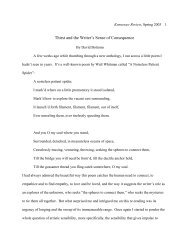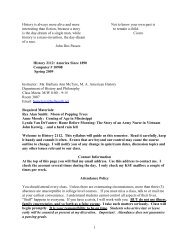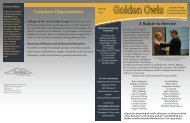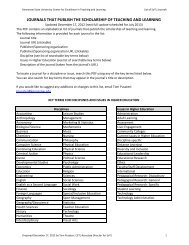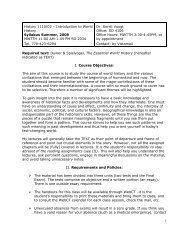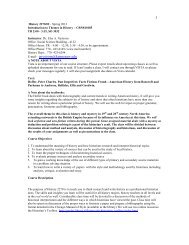Instructions for Development Plan
Instructions for Development Plan
Instructions for Development Plan
You also want an ePaper? Increase the reach of your titles
YUMPU automatically turns print PDFs into web optimized ePapers that Google loves.
Achieving Your Leadership Potential<br />
Completing the <strong>Development</strong> Action Form<br />
<strong>Instructions</strong>: Use this <strong>for</strong>m to think about your development be<strong>for</strong>e meeting with your leader. At<br />
that meeting the two of you will discuss and answer the questions on the front page. Afterward, you<br />
will fill in that page completely and provide a copy to your leader as a record of your meeting.<br />
Part 1: Skill/Knowledge/Competency <strong>Development</strong> Goal<br />
Goal:<br />
• Specify your skill, knowledge, or competency, and add clarifying in<strong>for</strong>mation as needed, such<br />
as specific key behaviors under a target competency. You can list more than one goal on this<br />
<strong>for</strong>m only if the method of acquiring the skill, knowledge, or competency is the same and the<br />
application and measurement are the same as well.<br />
Group or organizational payoff:<br />
• Note why your goal is important by explaining how it relates to the organization’s strategic<br />
direction or your group’s goals.<br />
Personal payoff:<br />
• Explain how your development in this area will enhance your success in your position and<br />
prepare you <strong>for</strong> future roles or positions.<br />
Part 2: Skill/Knowledge/Competency Acquisition (if required)<br />
(Note: This section is usually needed. Most people require coaching be<strong>for</strong>e a new assignment.)<br />
How will the learning be acquired (e.g., training, observation, coaching)?<br />
• You should have identified your preferred learning approach during your discussion with your<br />
leader. Choose methods that work best <strong>for</strong> your learning style and that will produce measurable<br />
changes in your skills, knowledge, or competency.<br />
What barriers/challenges might be encountered?<br />
• It is important that you and your leader together anticipate and discuss potential barriers and<br />
challenges. Those that have arisen in the past are a good starting point.<br />
What support/resources will be provided?<br />
• Make sure you have the time, budget, and resources to accomplish the development activity<br />
(e.g., attending a training program or taking on an assignment requiring extensive travel).<br />
Measures of successful acquisition:<br />
• List the measures you and your leader have agreed on <strong>for</strong> capturing your acquisition of the new<br />
skill, knowledge, or competency.<br />
Part 3: Skill/Knowledge/Competency Application<br />
Application opportunity:<br />
• Define the first application in appropriate detail.<br />
© <strong>Development</strong> Dimensions International, Inc., MMV. 1<br />
Permission is granted to photocopy this page <strong>for</strong> internal use only.
Achieving Your Leadership Potential<br />
How will progress in the application be tracked (progress measures)?<br />
• List the short-term progress measures (e.g., leader, peer observations) that will show how<br />
effectively you are applying your new learning.<br />
How will the outcome of the application be measured?<br />
• List the outcome measures you and your leader have agreed on <strong>for</strong> capturing the success of the<br />
application (e.g., quality data, changes in customer ratings).<br />
What barriers/challenges might be encountered?<br />
• As with skill acquisition, you will need to anticipate potential barriers and challenges to<br />
applying your new skill, knowledge, or competency.<br />
What support/resources will be provided?<br />
• Make sure you and your leader discuss the support and resources you will need to apply what<br />
you have learned.<br />
<strong>Development</strong> Results<br />
(Note: Complete this section once you have the outcome measures from your initial application.)<br />
Outcome of learning acquisition (or explanation of why not) (corresponds to Part 2):<br />
• Did the training or coaching occur, and was it helpful? If possible, document the learning (such<br />
as a report from a coach to your leader detailing how you demonstrated the skills, knowledge, or<br />
competency).<br />
Outcome of application (or explanation of why not) (corresponds to Part 3):<br />
• What were the results of your initial application? Include the outcome measures that capture<br />
your success.<br />
What insights did you gain from your development ef<strong>for</strong>ts?<br />
• If you were to undertake your development ef<strong>for</strong>ts again, what would you do the same or<br />
differently? What did you learn about how you develop best?<br />
What is the next use of the skill/knowledge/competency? More challenges necessary?<br />
• Have you achieved the development goal, or do you need more practice (i.e., another<br />
application opportunity)? Should you take on an opportunity that will be more challenging?<br />
What could have made your development process easier and more rewarding?<br />
• What could have speeded your development? Who could have helped?<br />
Unplanned <strong>Development</strong><br />
What unplanned opportunities did you take advantage of to build on the skill/knowledge/competency?<br />
• Did you have any un<strong>for</strong>eseen opportunities to develop the skill/knowledge/competency or to<br />
apply what you had learned? If so, what were they? What were your accomplishments?<br />
What were the outcome measures?<br />
• What measures show the outcome of the application opportunity or opportunities?<br />
© <strong>Development</strong> Dimensions International, Inc., MMV. 2<br />
Permission is granted to photocopy this page <strong>for</strong> internal use only.




